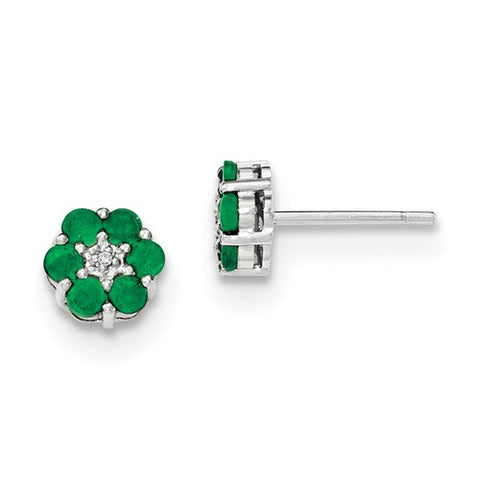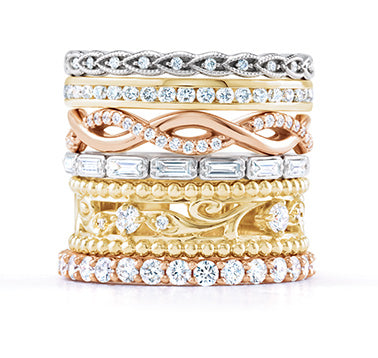Lifetime Warranty
24/7 Hour Customer Service
Free Shipping
30-Day Return
Moijey Fine Jewelry & Diamonds Blog
The Emergence of Emeralds
Originally posted on May 24th, 2017
Updated April 17th, 2020
The magnificent emerald jewelry in the featured image comes from the Gem and Mineral Exhibit at the Smithsonian. I guarantee that they are even more brilliant in person!
Recently, we wrote about the gloriousness of May's birthstone, emeralds. May is drawing to a close, what better way to conclude May than with the origins of lustrous emeralds?

In hydrothermal deposits, thousands of miles deep in the earth, the chemicals beryllium, aluminum, silicon, oxygen, and trace elements (responsible for the iconic green color) chromium, vanadium, and iron combine to grow into six-sided crystals. My picture from the Smithsonian is an ideal example of emerald's natural hexagonal shape.

The emerald mines of Colombia, in the eastern range of the Andes, produce some of the most beautiful emeralds in the world. For thousands of years, the Incas would mine the emeralds, cherishing their brilliant green color and setting them in their equally impressive Incan gold. In the sixteenth century, Spanish conquistadors seized the emerald treasures. The conquistadors' ships wrecked in the Atlantic Ocean, with emeralds rumored to be the size of ostrich eggs in their cargo. The Inquisition Necklace, housed at the Smithsonian, is a prime example of the quality of Colombian emeralds. Isn't it stunning?

The largest source of emeralds in Colombia is the Coscuez mines, which are responsible for roughly 60% of the world's emerald production. Other origins for the additional 40% of emeralds are in Zambia, Bahia, Northeast Brazil, and North Carolina. That's right. There is an emerald deposit in the United States, located in Hiddenite, NC.
Traditionally, gem cutters facet emeralds with step cuts. Step cuts are either square or rectangular facets. This emerald pendant is a prime example of the emerald cut.



Next week, it will be June. I can't believe it. At the same time, I'm excited because we get to divulge into the mysteries and joys of June's birthstones: pearls, moonstone, and alexandrite. Yes, June babies, you have more than one birthstone. Stop by next week and read about how excellent these birthstones are.
The Emergence of Emeralds
Originally posted on May 24th, 2017
Updated April 17th, 2020
The magnificent emerald jewelry in the featured image comes from the Gem and Mineral Exhibit at the Smithsonian. I guarantee that they are even more brilliant in person!
Recently, we wrote about the gloriousness of May's birthstone, emeralds. May is drawing to a close, what better way to conclude May than with the origins of lustrous emeralds?

In hydrothermal deposits, thousands of miles deep in the earth, the chemicals beryllium, aluminum, silicon, oxygen, and trace elements (responsible for the iconic green color) chromium, vanadium, and iron combine to grow into six-sided crystals. My picture from the Smithsonian is an ideal example of emerald's natural hexagonal shape.

The emerald mines of Colombia, in the eastern range of the Andes, produce some of the most beautiful emeralds in the world. For thousands of years, the Incas would mine the emeralds, cherishing their brilliant green color and setting them in their equally impressive Incan gold. In the sixteenth century, Spanish conquistadors seized the emerald treasures. The conquistadors' ships wrecked in the Atlantic Ocean, with emeralds rumored to be the size of ostrich eggs in their cargo. The Inquisition Necklace, housed at the Smithsonian, is a prime example of the quality of Colombian emeralds. Isn't it stunning?

The largest source of emeralds in Colombia is the Coscuez mines, which are responsible for roughly 60% of the world's emerald production. Other origins for the additional 40% of emeralds are in Zambia, Bahia, Northeast Brazil, and North Carolina. That's right. There is an emerald deposit in the United States, located in Hiddenite, NC.
Traditionally, gem cutters facet emeralds with step cuts. Step cuts are either square or rectangular facets. This emerald pendant is a prime example of the emerald cut.



Next week, it will be June. I can't believe it. At the same time, I'm excited because we get to divulge into the mysteries and joys of June's birthstones: pearls, moonstone, and alexandrite. Yes, June babies, you have more than one birthstone. Stop by next week and read about how excellent these birthstones are.






